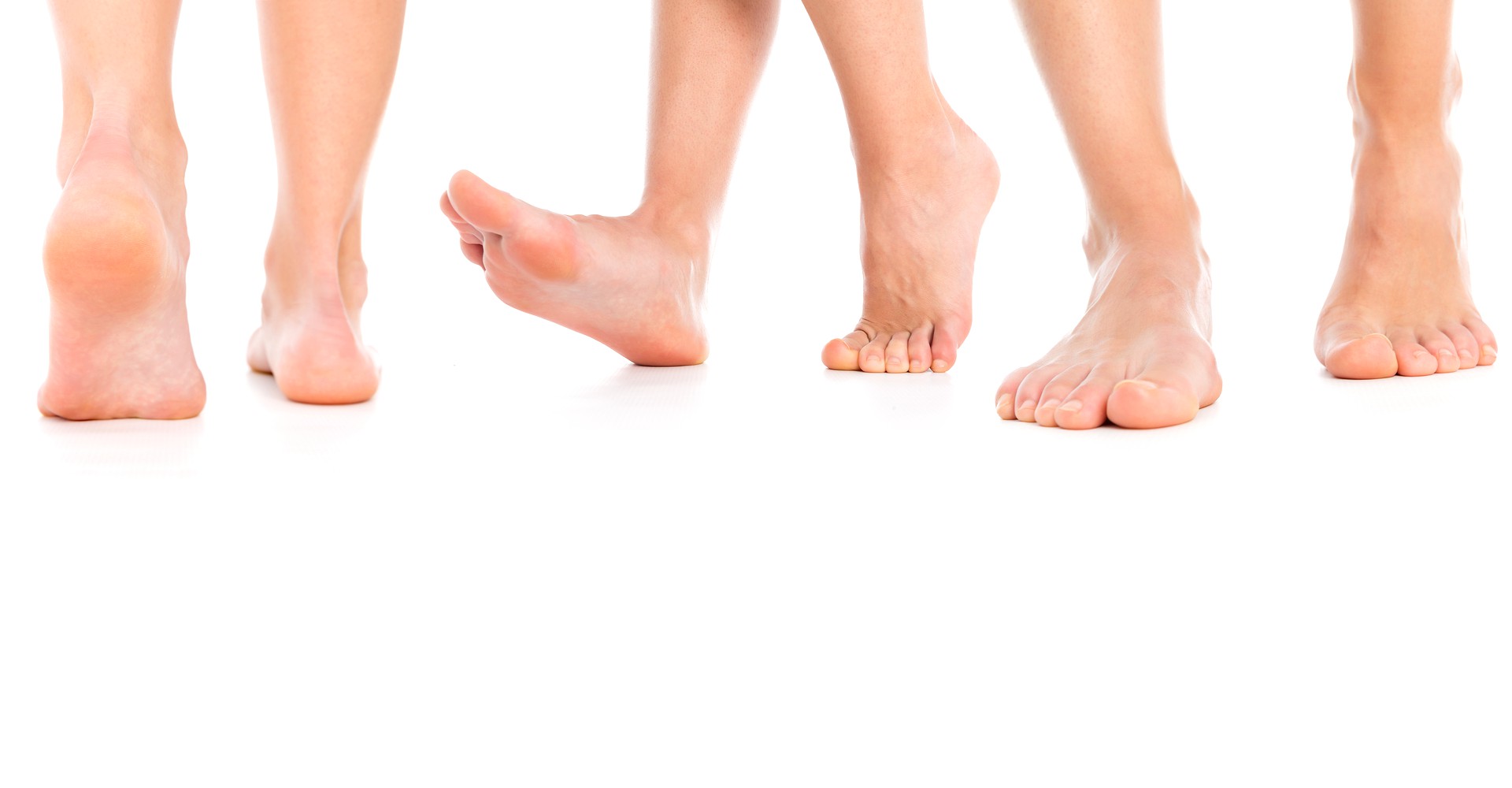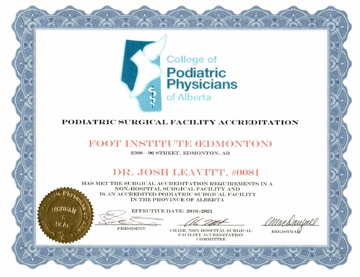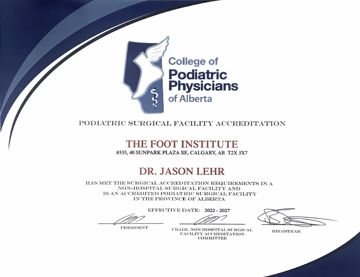The Foot Institute – Alberta
An Independent Associated Practice of Podiatric Physicians & Surgeons
TOLL FREE: 1-877-444-3668
Foot Surgery

Feet are remarkable pieces of engineering that take an enormous amount of wear and tear throughout an individual's life. Those with biomechanical faults such as pronation, supination, or those with other foot problems, accentuate this wear and tear on the feet. After a lifetime of use, these problems often result in structural foot deformities.
At The Foot Institute, our philosophy is to first assist in correcting the underlying structural problems. Often this is done through functional, prescription orthotics which are generally effective in correcting many foot problems and relieving associated pain. If a patient does not respond adequately to conservative treatment or if a structural change has taken place, then surgery may be desired. Minimally invasive procedures such as ingrown toenails, wart removals or excision of skin lesions can be done in the clinic. More extensive procedures such as bunions, hammertoes or neuromas, are performed in a surgery centre.
Patients have the option of being put to sleep by an anesthesiologist or remaining awake while under local anesthetic. Surgeries in Edmonton and Calgary can be performed at the Foot Institute's accredited Surgery Centres which are state-of-the-art facilities fully licensed by the Alberta Government. Patients requiring or considering the possibility of surgery require a pre-operative evaluation before a surgery date can be scheduled. In Edmonton, patients also have the option of having surgery performed in the surgery suite located at the main clinic.
The Foot Institute Doctors who perform your surgery have completed residencies specializing in surgery and have performed hundreds of surgeries on the foot and ankle. They utilize many advanced surgical techniques so that patients generally are able to walk in and out of the surgical facility unassisted. Retrospective studies from Doctors at The Foot Institute indicate that approximately 70% of surgical patients do not require pain medication following surgery. This is accomplished through the use of skilled surgical techniques, anti-inflammatory medication, and ice packs that control swelling. In most cases, patients are able to return to a moderate activity level within a few days following surgery.
Bunions
Bunions are a bony prominence or bump on the medial side of the foot behind the big toe. They are usually produced over a period of time and by a combination of factors such as activity level, poor fitting shoes, foot structure, work related stresses and genetics. When a bunion becomes well formed, a fluid sac will often form between the bone and the skin overlying the bump. Once formed, pressure from the shoe will cause the sac to fill with fluid causing inflammation and pain. Doctors at The Foot Institute will generally prescribe functional orthotics to alleviate potential underlying problems that may have caused, or attributed to, the formation of the bunion. This is necessary so that following surgery the likelihood of recurrence is minimized. There are many surgical variations depending on the nature of the bunion, but it will generally take the Surgeon approximately one hour to complete the surgery.
In a typical bunion procedure, Foot Institute Doctors will surgically remove the prominent part of the first metatarsal bone with or without cutting and repositioning the joint surface. Often, there is an increase in the angle between the first and second metatarsals which is adjusted by making a cut (often triangular) in the head of the first metatarsal bone. This allows Doctors to laterally shift the head of the first metatarsal which is then fixed into place by surgical screw(s) or pins. By utilizing this advanced procedure, patients are able to commence weight-bearing activities (i.e. walk) immediately after surgery as weight actually compresses the bone together thus assisting in the healing process. Pain is usually minimal and by utilizing a post-operative shoe, most patients can resume moderate activities within 2-4 days of surgery. Active individuals or those with occupations that require long periods of standing or walking, may require several weeks of inactivity prior to resuming regular activities.
Hammertoes
Hammertoes are caused when the muscles of the toes are no longer balanced due to muscle contraction – often as a result of a biomechanical fault. As soft tissue contracts, the underlying bone structure is changed causing friction or rubbing between the top of the toe and the shoe often causing corns. In time, toes lose their flexibility, joints fuse, and the toes become rigid, inflexible and painful. In addition to being irritating corns often breakdown and become infected. In serious cases they may even ulcerate and cause other and more serious foot problems.
Most causes of hammertoes can be treated with functional orthotics, but in cases where orthotic therapy is not effective, surgery may be necessary. In this surgical procedure, soft tissue that is causing the contraction is released and the involved joint is surgically remodeled to allow the toe to lay straight. The toe is then splinted or fixated in such a way that when the soft tissue heals, the toes remain in the proper position. One hammertoe procedure usually takes 30 minutes to complete. Following surgery, functional orthotics are recommended to minimize the chance of a reccurrence. Patients can generally return to a moderate activity level within 2-3 days following surgery.
Neuromas
Neuromas are a common and very painful problem presenting as burning, tingling, numbness or shooting pain that radiates from the ball of the foot and extends most often to the 3rd and 4th toes. Gait or structural problems often cause pressure in the ball of the foot, which often injures or bruises the protective covering of the nerve. Once injured, a process called fibrosis or scarring occurs and the protective covering becomes enlarged.
Orthotic therapy is often effective in reducing stress on the area and minimizing discomfort, but will not always solve the problem if matters have progressed such that scar tissue surrounding the nerve is too enlarged. In this instance, surgical intervention is necessary to remove the neuroma and can offer permanent pain relief.
Surgery for neuromas can be done from either the top or the bottom of the foot and involves a small incision. As this surgery involves only soft tissue, most people have minimal pain and discomfort following surgery. After surgery, patients can expect to experience numbness in the area. This is normal and as the healing process becomes complete, some sensation may be restored. Following surgery, it is important for patients to wear functional orthotics to help prevent recurrence of this deformity.
Pre and Post Operative Examinations
During the pre-operative exam, a patients condition will be discussed, various treatment options explored, and possible complications of surgery explained. Patients are asked to inform their Family Physician and ensure that there are no medical conditions that would affect the surgery. In addition, a prescription for pain medication may be obtained although generally this is not necessary.
In order to reserve OR time, patients are required to pay for all surgical services prior to the day of the surgery. Generally this should be done immediately following the preoperative consultation. Surgical fees vary depending on the length and nature of the procedure. Patients will be informed of the cost during the preoperative exam. Questions regarding fees can also be discussed at this time. As surgical fees are often covered by private insurance, patients are encouraged to contact their insurance company to verify coverage and related details. Receipts for surgical fees should be saved as they are generally tax deductible.
Risks and Complications of Surgery
As with all surgical procedures, there is always a risk of complications, although possible risks and complications from most foot surgeries are rare. Foot Institute Doctors will explain possible complications and alternative treatment options during the preop exam. Patients are required to sign a consent form prior to the surgery indicating that the complications and risks associated with the surgery have been fully explained and understood.
The most usual complication patients experience from any given surgery is postoperative infection that although not common, can occur in some instances. As a precautionary measure, antibiotics will often be prescribed to help prevent the chance of a postoperative infection from occurring. Other complications may include prolonged swelling, more than expected pain, or a longer recovery time. Recovery time following any surgery is dependent on an individuals over-all state of health, constitutional make up, activity level and many other related factors. Other possible risks or complications specific to the surgery or the patient's individual condition will be noted on the patient consent form.
The vast majority of patients respond very well to surgery and progress rapidly. After surgery, patients will be closely monitored to help ensure a proper recovery and a positive outcome. Patients can expect to be seen on a weekly basis for a period of two to three weeks following surgery and then as directed depending on the procedure, the severity of the problem, and individual needs.




